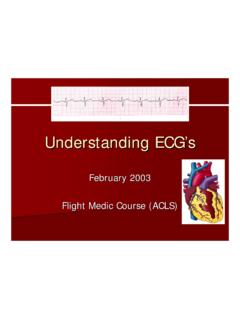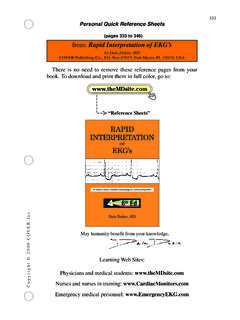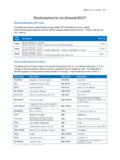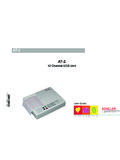Transcription of Basic ECG Interpretation
1 Basic ECG Interpretation Learning Package Bendigo Health 2009. All rights reserved. 1 CCCooonnntttiiinnnuuuiiinnngggNNNuuurrrs sseee EEEddduuucccaaatttiiiooonnn To get the most out of the Basic ECG Interpretation Study Day please read this Package prior to attendance. At the study day, you will be required to undertake a pre test so it is important the information has been read properly. If you are not confident in your ECG knowledge and / or it has been a long time since you learned how to do an ECG, do not be overwhelmed by the Learning Package. If there are any aspects you do not understand or are not sure of, bring your questions to the Study Day where they can be answered. The objective of the CNE ECG education is to give you the skills to conduct a good quality ECG and be able to identify abnormalities; this Package and the study day are designed to achieve that objective and have you feeling confident.
2 And may help save a Happy reading! Welcome to the (a)ECG Interpretation learning package. This package has been designed for Division one and Division two nurses in the Grampians and Loddon Mallee regions. ECGs are a useful tool in cardiac assessment as they give us information about our patient s heart activity. More specifically, the ECG waveform represents a sequence of electrical impulses across the myocardium, or heart muscle. Irregularities or abnormalities can occur at any stage in this sequence, which is why it s so important to be able to read ECGs correctly. This package has been designed to teach you about how to correctly interpret rhythm strips and ECGs within the health care environment. During this package, we ll learn about many different aspects of ECG Interpretation . We ll cover the following topics: ECG Fundamentals Rhythm Interpretation ECG Interpretation .
3 In this section of the course, we ll cover the basics of how an ECG works. We ll learn about: ECG How it works ECG Leads ECG Paper Basic ECG Interpretation Learning Package Bendigo Health 2009. All rights reserved. 2 CCCooonnntttiiinnnuuuiiinnngggNNNuuurrrs sseee EEEddduuucccaaatttiiiooonnn An ECG is a linear graphic recording of the electrical impulses generated in the heart during the cardiac cycle. The electrical impulses are measured by electrodes on the skin. Electrodes on different sides of the heart measure the activity of different parts of the heart muscle. The ECG displays the voltage between pairs of these electrodes, and the muscle activity that they measure. This indicates the overall rhythm of the heart and abnormalities in different parts of the heart muscle. It s the best way to measure and diagnose abnormal rhythms of the heart.
4 In ECG terms, a lead is a combination of electrodes that form an imaginary line in the body along which electrical signals are measured. In a 12 lead ECG, three groups of leads are used, each looking at different aspects of the heart: Bipolar limb leads Unipolar limb leads Unipolar precordial (chest) leads. Each lead records the electrical signals of the heart from a particular combination of recording electrodes which are placed at specific points on the patient's body. Basic ECG Interpretation Learning Package Bendigo Health 2009. All rights reserved. 3 CCCooonnntttiiinnnuuuiiinnngggNNNuuurrrs sseee EEEddduuucccaaatttiiiooonnn The bipolar limb leads are known as leads I, II and III. They are also called standard leads. The bipolar leads are placed on each of the patient s arms and legs. They use a single positive electrode and a single negative electrode between which electrical potentials are measured.
5 The bipolar leads view the frontal plane of the heart from these two points. The unipolar limb leads are known as leads aVR, aVL and aVF. These leads use a single positive electrode and a combination of the other electrodes to serve as a composite negative electrode. Like the bipolar leads, unipolar limb leads record electrical activity along the heart s frontal plane, but from a different angle. III Il aVR aVL aVF-++- - ++ + -Right Arm Electrode Left Leg Electrode I+ Left Arm Electrode Basic ECG Interpretation Learning Package Bendigo Health 2009. All rights reserved. 4 CCCooonnntttiiinnnuuuiiinnngggNNNuuurrrs sseee EEEddduuucccaaatttiiiooonnn The unipolar precordial leads are known as leads V1, V2, V3, V4, V5 and V6. These leads are placed directly on the chest and view the heart s electrical activity in the horizontal plane. Each of the precordial, or chest leads, can be read as pairs looking at different views of the heart.
6 Leads V1 and V2 have a septal view. Leads V3 and V4 have an anterior view. Leads V5 and V6 have a lateral view. V1 V2V3V6V5 V4 Ant Septal LatLeft Ventricle Basic ECG Interpretation Learning Package Bendigo Health 2009. All rights reserved. 5 CCCooonnntttiiinnnuuuiiinnngggNNNuuurrrs sseee EEEddduuucccaaatttiiiooonnn Now, let s take a look at the ECG paper. The ECG paper provides a measurement of the heart s electrical impulses measured against time. ECG paper is divided into 1 millimetre small squares and 5 millimetre large squares. The paper moves through the ECG at 25 mm per second. This means that, on the horizontal axis, one small square equals seconds. One large square, made up of 5 small ones, equals seconds. On the vertical axis, the paper shows the amplitude of the electrical impulse, which is measured in millivolts (mV). In this section of the package, we ll learn about rhythm Interpretation .
7 We ll cover: Determining Heart Rate The PQRST Complex The P Wave The PR Interval The QRS Complex The T Wave Normal Electrical Impulse Conduction The Pacemakers of the Heart Step-by-step Rhythm Interpretation 1mm box = sec 5mm box = 5x5mmbox=1sec10mm tall=1mV Basic ECG Interpretation Learning Package Bendigo Health 2009. All rights reserved. 6 CCCooonnntttiiinnnuuuiiinnngggNNNuuurrrs sseee EEEddduuucccaaatttiiiooonnn Let s look at how to measure heart rate on an ECG. First, count thirty large boxes on the ECG paper. As we ve learned, each large box equals seconds. So 30 large boxes gives you a six second strip. Next, count the number of beats, or complexes, within the six second strip. Multiply this number by ten. This will give you the number of heart beats per minute.
8 It s important to note that this method is accurate only to within ten beats per minute. 6 sec strip / 30 squares 1234568979 complexes in 6 seconds. 9 x 10 means the heart rate is roughly 90 bpm Basic ECG Interpretation Learning Package Bendigo Health 2009. All rights reserved. 7 CCCooonnntttiiinnnuuuiiinnngggNNNuuurrrs sseee EEEddduuucccaaatttiiiooonnn Now, let s look at the PQRST complex. The PQRST complex is a systematic method of interpreting rhythm on an ECG. In this section of the course, we ll look at: The P Wave The PR Interval The QRS Complex The T Wave The Pacemakers of the Heart. Normally, the heart beats with a regular rhythm, generated by the sinoatrial, or SA, node. The SA node is the heart s pacemaker it determines how quickly the heart beats. The P wave represents the electrical activity of the heart s atria when the SA node is activated.
9 So, why is the P wave is important? Firstly, because we can recognise various cardiac arrhythmias by looking at the relationship between P waves and QRS complexes, which we ll learn about shortly. Secondly, because the shape and duration of P waves may also indicate atrial enlargement. P PR Interval Q R S T QRS Duration Basic ECG Interpretation Learning Package Bendigo Health 2009. All rights reserved. 8 CCCooonnntttiiinnnuuuiiinnngggNNNuuurrrs sseee EEEddduuucccaaatttiiiooonnn The duration of the P wave is normally, about to seconds, covering 2 to small squares horizontally on the ECG paper. The amplitude, or height, of the P wave is or less, covering approximately squares vertically on the ECG paper. The P wave is positive in most leads, which means it s above the baseline, or isoelectric line, on the ECG paper. It should also be rounded, not peaked, pointy or notched.
10 The PR interval is measured from the beginning of the P wave to the beginning of the QRS complex. It represents the time taken for the electrical impulse to spread through the atria and down through the atrioventricular node, or AV node, to the heart s ventricular muscles. The AV node is a secondary pacemaker, acting as a back up to the SA node. The PR interval on an ECG should measure to seconds, covering 3 to 5 small boxes on the ECG. If the PR interval is abnormally short or abnormally long, it may indicate a heart problem. The QRS complex on an ECG represents the electrical activity associated with the activation of the heart s ventricles. In other words, it shows the depolarisation of the ventricles. It may have three components: The Q Wave The R Wave The S Wave The Q Wave is the first negative deflection on the complex.


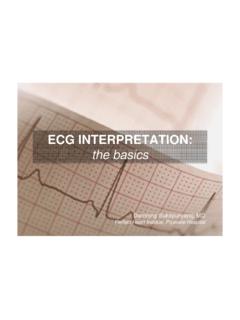
![ECG Interpretation -JPC-PA [Mode de compatibilité]](/cache/preview/e/6/1/8/b/5/9/7/thumb-e618b597b0b1fc3eb9eb9fd2fe396453.jpg)
